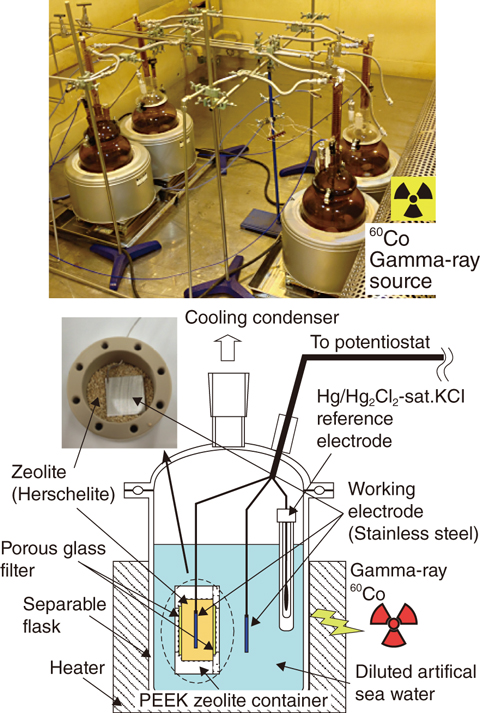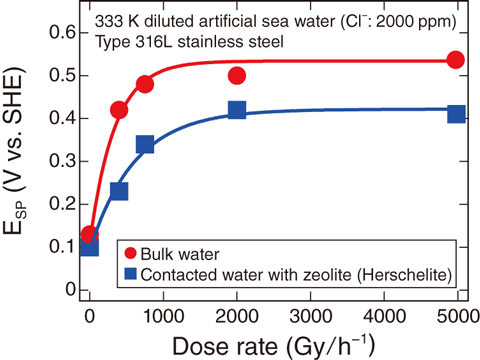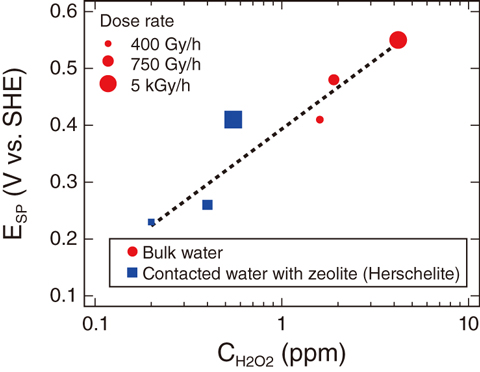
Fig.1-15 The appearance of the test equipment in the gamma-irradiation room and a schematic of the electrochemical-testing cell

Fig.1-16 The relationship between the dose rate and the spontaneous potential, ESP, of type 316L stainless steel in the bulk water and the system in contact with zeolite

Fig.1-17 The relationship between the spontaneous potential ESP of type 316L and hydrogen peroxide concentration CH2O2 in the bulk water and the water in contact with zeolites under irradiation
A cesium (Cs)-adsorption system was installed in the TEPCO’s Fukushima Daiichi NPS after it was damaged by the tsunami in 2011. This Cs-adsorption system removes radioactive Cs from the contaminated water using adsorption vessels made of KURION, which contains zeolites (Herschelite).
The spent Cs-adsorption vessels were stored in a provisional storage facility; their insides were washed with fresh water and drained to remove all seawater components. However, if the spent Cs-adsorption vessels are stored for a long period, the stainless steel in these vessels may still undergo corrosion owing to the chloride ions (Cl¯) present in the water remaining in the vessel. In addition, the Cl-ion concentration in the water remaining in the vessel will increase because of water evaporation owing to the increase in the temperature inside the vessel, owing to the heat generated by the decay of radioactive Cs. Furthermore, hydrogen peroxide (H2O2) may be produced in the remaining water owing to the radiation from the adsorbed Cs; this would also increase the likelihood of the stainless-steel corrosion.
In this study, we performed electrochemical tests on stainless steel in zeolite-containing diluted artificial seawater under gamma-ray irradiation. This was done to investigate the effects of gamma-ray irradiation upon the spontaneous potential, ESP, of stainless steel in systems in contact with zeolites as well as to study the effects of coexisting zeolites on the conditions that can cause the localized corrosion of the stainless steel.
The electrochemical tests were performed at the 60Co gamma-ray-irradiation facility at the Takasaki Advanced Radiation Research Institute of the Japan Atomic Energy Agency. Fig.1-15 shows a schematic diagram of the apparatus used for the electrochemical tests. The dose rate at the location of the electrochemical test apparatus was set to 400 Gy/h, 750 Gy/h, 2000 Gy/h, or 5000 Gy/h. These values were selected because they were close to the estimated value of the dose rate (755 Gy/h) at the bottom of the spent-Cs adsorption vessel (KURION), as calculated from the maximum amount of Cs adsorbed. Furthermore, these values allowed the effects of a large absorbed-dose rate (5000 Gy/h) to be evaluated. The distance from the 60Co radiation source was adjusted to achieve these dose rates.
Fig.1-16 shows the effects of the dose rate and contact with the zeolite upon ESP. Under gamma-ray irradiation, ESP increased along with increase in the dose rate; this was true both in bulk water and in the system with coexisting zeolite. The ESP value in the system in contact with the zeolite under irradiation was less noble than that in bulk water unconnected with zeolite. Contact with the zeolite suppressed the increase in the potential under irradiation; this decreased the possibility of localized corrosion occurring during long-term storage.
Analyses of the water samples were performed after the gamma-ray-irradiation tests in order to determine the concentrations of H2O2 and DO in bulk water and in water samples that came in contact with zeolite. The value of ESP changed almost linearly with the logarithm of the H2O2 concentration. It can be seen that the increase in ESP under irradiation was primarily dependent upon the H2O2 concentration. Furthermore, it is clear that ESP decreased owing to an increase in the rate of decomposition of H2O2 in the case of the systems in contact with the zeolites. Accordingly, it can be surmised that the coexistence of zeolite can suppress the increase in the potential under irradiation (Fig.1-17).
Parts of this study were performed as a union member of the International Research Institute for Nuclear Decommissioning (IRID) in accordance with the Project of Decommissioning and Contaminated Water Management in the FY2014 supplementary budget from the Agency for Natural Resources and Energy, Ministry of Economy, Trade and Industry of Japan (METI).